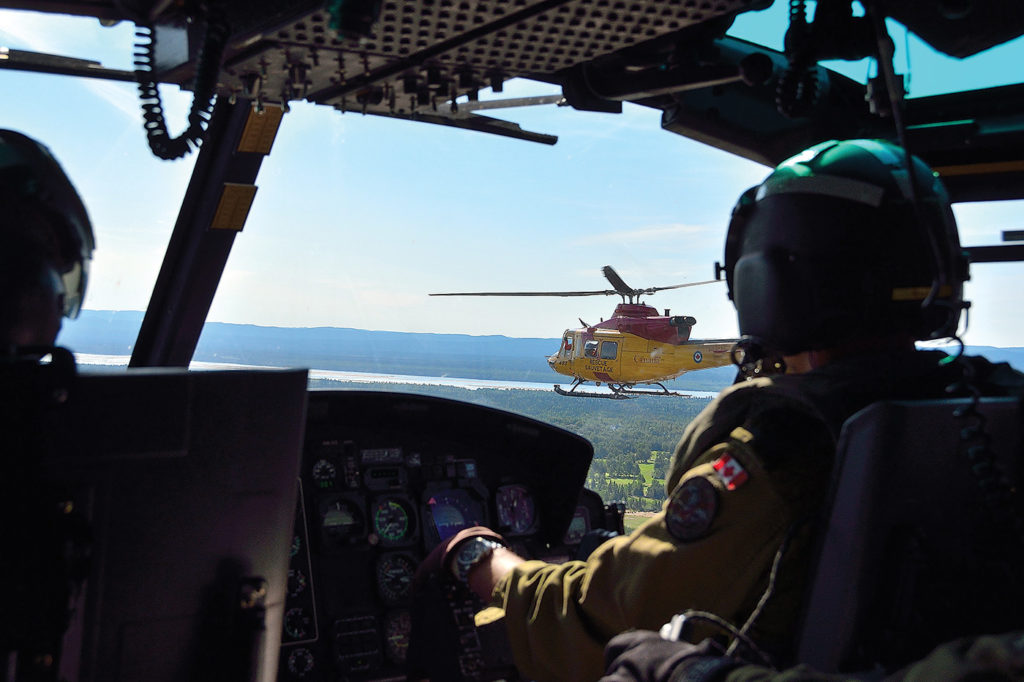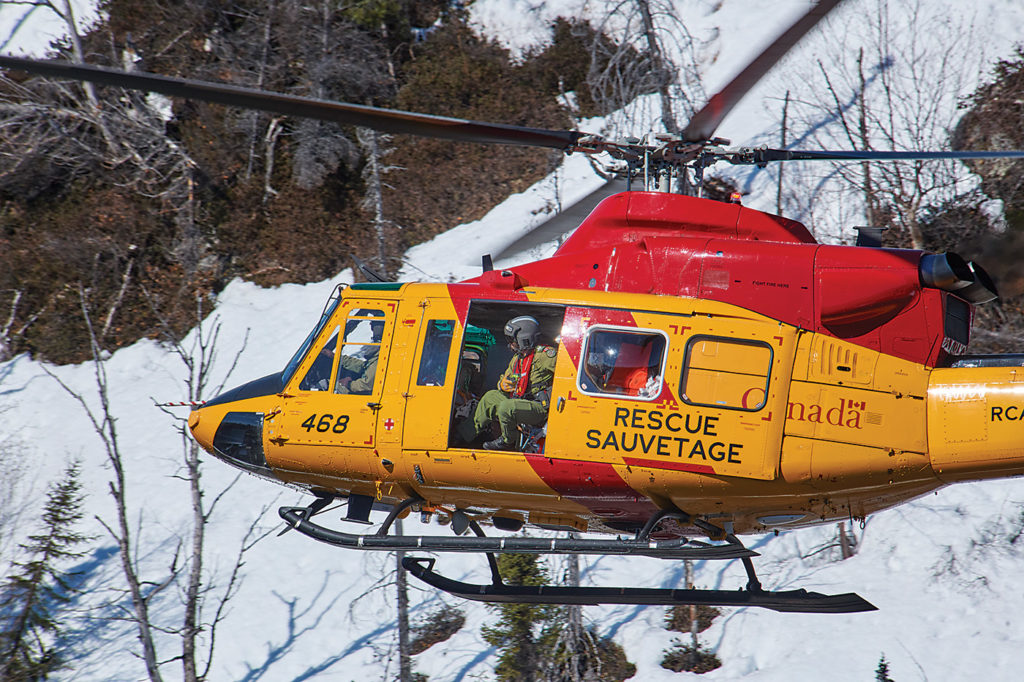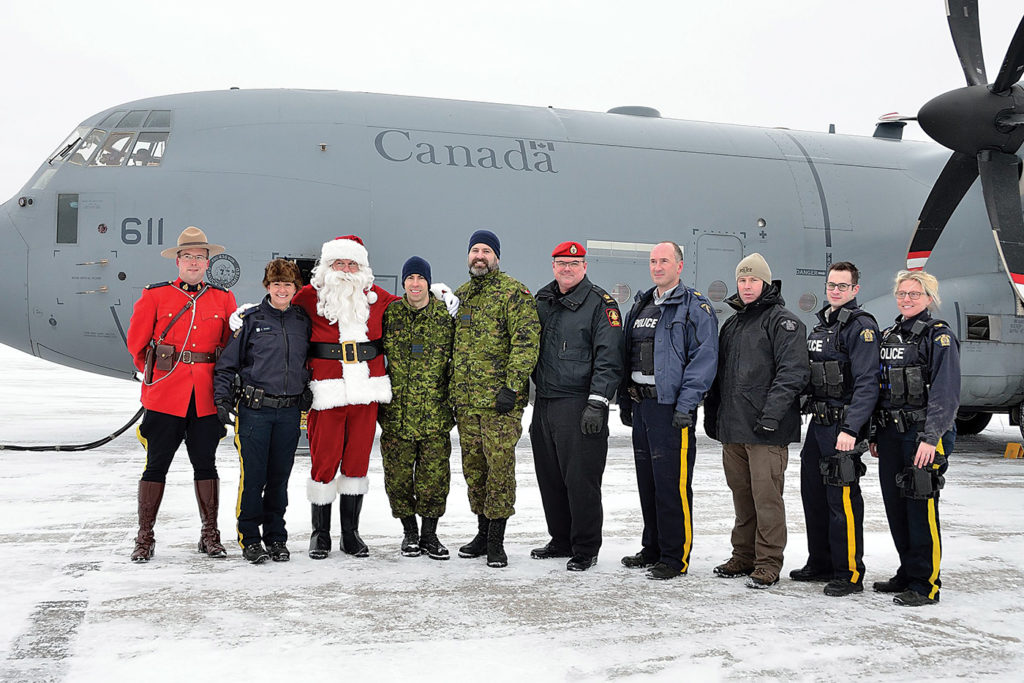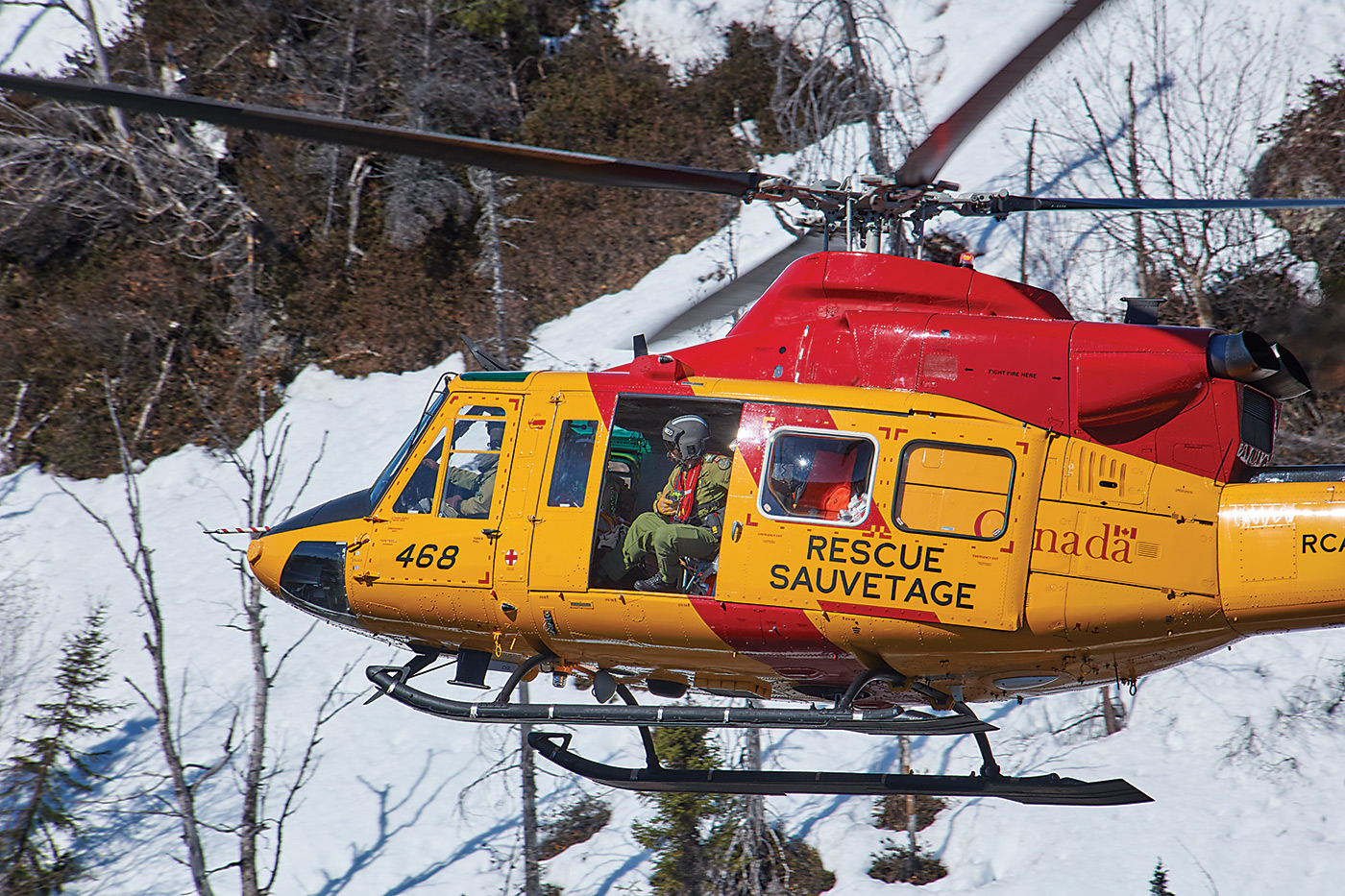Estimated reading time 13 minutes, 7 seconds.
One of the best-kept secrets in the Royal Canadian Air Force (RCAF) is 5 Wing Goose Bay, a tight-knit posting in rural Labrador, about four kilometres north of the Churchill River and a near 400-kilometre (km) drive west of the Labrador Sea.

Today there are only about 75 military personnel at 5 Wing, a former U.S. Air Force base that hummed with the activity of about 12,000 people during the Cold War. But despite its small staff, the Wing oversees a massive geographic area–nearly 295,000 square kilometres, roughly the size of the United Kingdom–and it’s an important NORAD partner that punches high above its weight.
“We are an isolated location,” said LCol Stephane Racle, wing commander. “We are sometimes out of mind, out of sight.
“But there’s a lot of good things that happen here … when we do things well here, we want to make sure that those things get recognized. If we don’t make an effort to do that, it’s easy to get forgotten.”
5 Wing is also home to 444 Combat Support Squadron, whose primary mission is to respond to local emergencies that occur during flight operations and military exercises at the base. The squadron is equipped with three CH-146 Griffon helicopters and also provides a range of support to civil authorities.

Military postings at 5 Wing usually last only three years, but many civilians also work there, and some have stayed for decades. The small staff encourages a level of camaraderie that doesn’t exist at some larger Wings, and officers have made morale and well-being a key priority.
“If we don’t have that, we can’t do anything else,” said Racle. “We also encourage, at all levels, people to get engaged in the community.”
“Things have changed in terms of what the base is doing,” he added. “It’s not what we did 10 years ago; it’s not what we did 15 years ago; it’s not even what we did five years ago, really. But there is a definitive need for what we’re able to provide.”
A Multinational History
Construction of what is now 5 Wing Goose Bay began in 1941 to accommodate anti-submarine patrol aircraft and staging aircraft for Great Britain during the Second World War.
The area was chosen in part for its strategic location and its excellent flying weather, and the base was also a fuelling stop on the Allies’ transatlantic carrier route. A total of 22,500 fighters, bombers and transports built in North America staged through the base during the conflict.

During the Cold War, Allied forces used Goose Bay for low-level flying training on the base’s massive 130,000-square-kilometre flying training area. Aircraft dipped as low as 100 feet during these training exercises, taking advantage of the sprawling open spaces and low population density.
In the 1950s a line of radar sites was established along the Labrador coast, and Goose Bay’s main responsibilities shifted to surveillance, identification and interceptor control for the Labrador area. Outlying radar sites reported to the U.S. Air Force-manned Melville Manual NORAD Control Centre, near the current base.
5 Wing evolved over the next few decades from a small station to a medium-sized base that supported multinational flying operations, including low-level flying training for the German, Italian and Royal Netherlands air forces. In 1976, all Strategic Air Command units withdrew from the base, and the U.S. Air Force contingent reduced its size significantly.

Fighter jet low-level flying operations over Labrador stopped in 2005, when all Allied forces withdrew from 5 Wing. Today, the Wing’s priorities are centred around support to NORAD operations and austere environment training. Achieving this requires a focus on operational excellence and strong relationships within the Labrador community.
“We’re very pleased and very proud to say we have an excellent relationship with the community,” said Racle. “And when I say the community, I don’t just mean Happy Valley-Goose Bay; I mean the whole of Labrador.”
A training range for all seasons
The flying environment in Labrador is larger than some European countries, with higher altitude blocks up to 60,000 feet, and complex terrain, licensed drop zones and a training area authorized for both day and night use.
5 Wing’s Practice Target Area, located about 65 nautical miles south of Goose Bay, is only accessible by air and has two airstrips that stretch for 5,200 feet and 1,500 feet, respectively.

The facility includes an air-to-ground range that allows for precision-guided munition (PGM) drops, as well as laser engagement capability and helicopter door-gun training. A smaller but equally important 360-degree small arms range allows for live-fire fighting in built-up area structures.
As part of its environmental management commitment, 5 Wing consistently cleans both ranges, gathering an estimated three million pounds of range scrap, transporting it with a CC-130J Hercules aircraft.
“Every year, with the frost and everything, they resurface,” said Maj Nicole Deschamps, Wing operations officer. “The guys go out and collect everything they can. We clean it up every year or so.”
As of spring 2019, the base expected to have a full fuel farm at the Practice Target Area, allowing helicopters to refuel on site rather than returning to the base during support missions.
“That way they can actually live out there,” said Deschamps. “All the crews can come, deploy, live out there, eat out there. We have a kitchen, we just need a cook. We ship everything in.”

In 2018 the German Air Force, a frequent visitor, completed several flying operations at 5 Wing, including multiple type ratings for Airbus A319 and A340 aircraft, and low-level night vision goggles training on Airbus A400M aircraft. NORAD carried out a North Warning System (NWS) assessment at 5 Wing last year, and CF-188 pilots from 3 Wing Bagotville, Que., engaged in weapon drops on the practice target area.
Ground activity in 2018 included winter warfare training, U.S. and German special forces training, Exercise Northern Sojourn and Exercise Terra Traverse and multiple Canadian Ranger Patrol Group (CRPG) events.
“When I started on the base in ’88 … the base was booming,” said Liz Johnson, the Wing properties officer. “The Italians, the British, the Dutch and the Germans were here, so the activity level was incredible. When they left, we went through a [period when] we weren’t sure what was going [to happen] to the base. Now we’ve progressed to more ground exercises, so the scope has changed.”
“There’s been an increase in the amount of Canadian units that use the Wing for summer and winter training,” added Johnson. “Mostly winter, because we have a long winter and a lot of snow.”
A supportive community
Just before the end of January 2019, 5 Wing held the grand opening for its new military family resource centre (MFRC), a vibrant building that offers programs for children and teens, as well as mental health services, adult First Aid classes and community orientations for RCAF members.

“We’re here to provide support to the military community,” said Joan Harvey, executive director at the MFRC. “We’re here to provide programs and services, be responsive to their needs in this isolated posting.”
The MFRC is a key part of 5 Wing’s commitment to good morale, and a direct response to the needs of the community that has seen an increase in young families and small children over the past three years. Since the base population is small, leaders can adjust programming almost immediately.
“We can be more responsive and more flexible in our programming, which is really what you need to be doing in these kinds of locations,” said Harvey. “We can reach our people really easily. I think that’s probably the uniqueness [of 5 Wing], is our relationship with our families and our members.”
MRFC has a staff of 12 who organize large family events throughout the year, including community meals, a winter carnival and an annual block party in June. An Inuit elder visits frequently to teach members how to make mittens, slippers and other crafts.
“She’s a bit of a celebrity up here,” said Harvey. “It might sound–‘Oh just a craft course.’ But when you’re in an isolated posting … it just brings people out of the house in the winter, interacting with other people.
“It’s great for the staff to be around when these courses are going on, because that’s when you really get to know people. And you have that relationship built that, if there’s an issue or something is wrong, you can usually find out at a really low level before it gets too big.”

Communication with the larger community is critical because low-level flying near Goose Bay can impact those living and working in the region, including Indigenous groups in Labrador and eastern Quebec, local wildlife and mineral quarry explorers whose blasting practices can affect low-flying aircraft.
With this in mind, 5 Wing proactively reaches out to ensure aircraft don’t negatively affect local populations and industries. Silas Bird, in a community liaison role, serves as the first point of contact for many affected people, including the three Indigenous groups in Labrador.
Wing staff also track local caribou and moose herds, as well as other wildlife, to ensure low-level flying doesn’t impact animal populations, either.
“It’s a way to deconflict military activity with ground activity,” said Bird. “The idea was basically to say, ‘Wherever you’re going to be, let us know so that we can avoid those particular sites.’ ”
Isolated, but always open
In addition to almost 80 military personnel, 5 Wing employs approximately 90 civilians. Around 250 employees of Serco Canada, a service delivery company, provide everything from aircraft control to cleaning, plumbing, carpentry and snow removal.
The latter is one of Serco’s main challenges at Goose Bay–the white stuff falls persistently, and blowing snow is a near-constant concern during winter. Another challenge is geography. The ferry to Newfoundland is about 620 km away; the nearest island city, Corner Brook, is another 350 km by car.
“Getting delivery of parts and materials is a challenge,” said Tom Wheeler, site manager at Serco for Happy Valley-Goose Bay. “And it’s expensive to get some of those parts in here.”
Still, the airfield at Goose Bay rarely shuts down, and Serco staff have received glowing reviews from 5 Wing administrators.
“Their air traffic controllers … get nothing but high praise from a DND perspective,” said Maj Andrew Vandor, commanding officer of 5 Wing’s Mission Support Squadron. “When we get those reports, they come back with very high ratings.”
A great job to embrace
Many members of the military staff at 5 Wing play multiple roles. “I have like 10 hats I have to wear at different levels,” said Capt Kevin Wilbur, whose official title is Wing Comptroller.
“Everything goes on like every other Wing,” said Wilbur, who was previously posted to 15 Wing Moose Jaw, Sask., and 12 Wing Shearwater, N.S. “You just have less people to do it, so you do more things than what you normally do.”
Wilbur is part of the financial team at 5 Wing that oversees spending and revenue, but he’s also commander of the Wing Auxiliary Security Force (WASF), which supports military police in the event of a massive security incident.
“I am probably the only logistics officer and financial officer in the CAF [Canadian Armed Forces] who’s a WASF commander,” he said. But it’s a lifestyle many come to embrace.
“It’s a great job,” said WO Nancy Chicoine, the superintendent clerk at 5 Wing. “Goose is one of our best postings we’ve ever had. We came here with the notion that it was going to be, ‘Let’s just do it and get it over with and get out of here,’ because postings are not generally optional … [but] we have had a fantastic posting here.”
You have to go along with the mindset in Goose Bay, she said. You have to find your groove, and the isolation can be a bit much. But you have to make the best of it.
“It can become a real habit to just stay on base,” said Chicoine. “But it’s really important that you get out and see what Goose Bay is all about. Once you do that, it’s a very memorable posting.”

